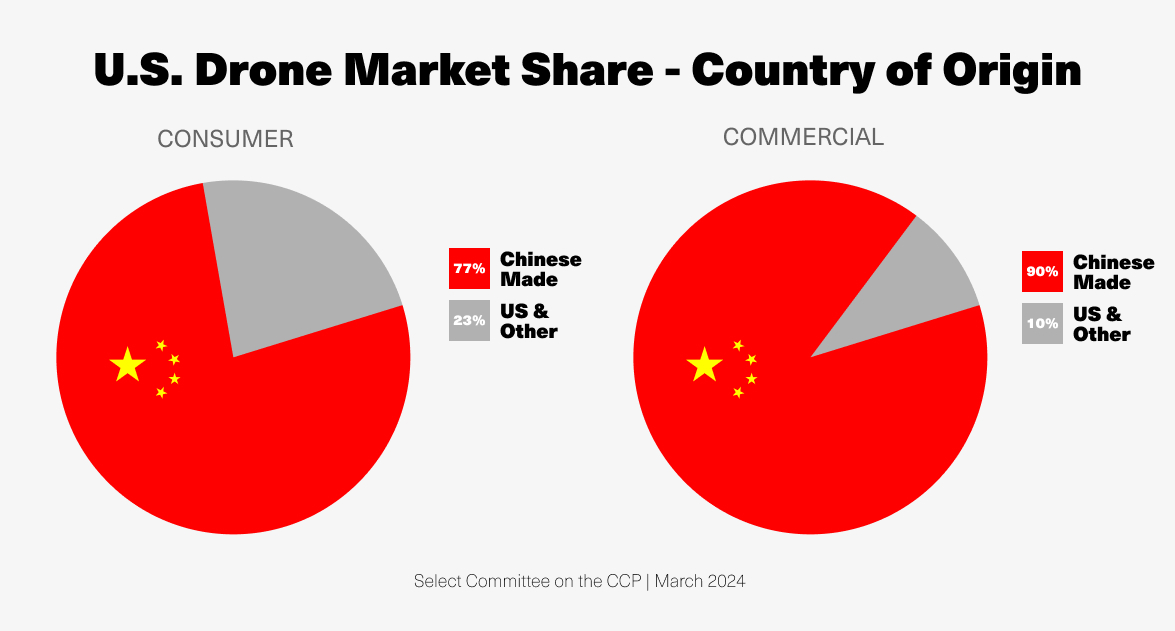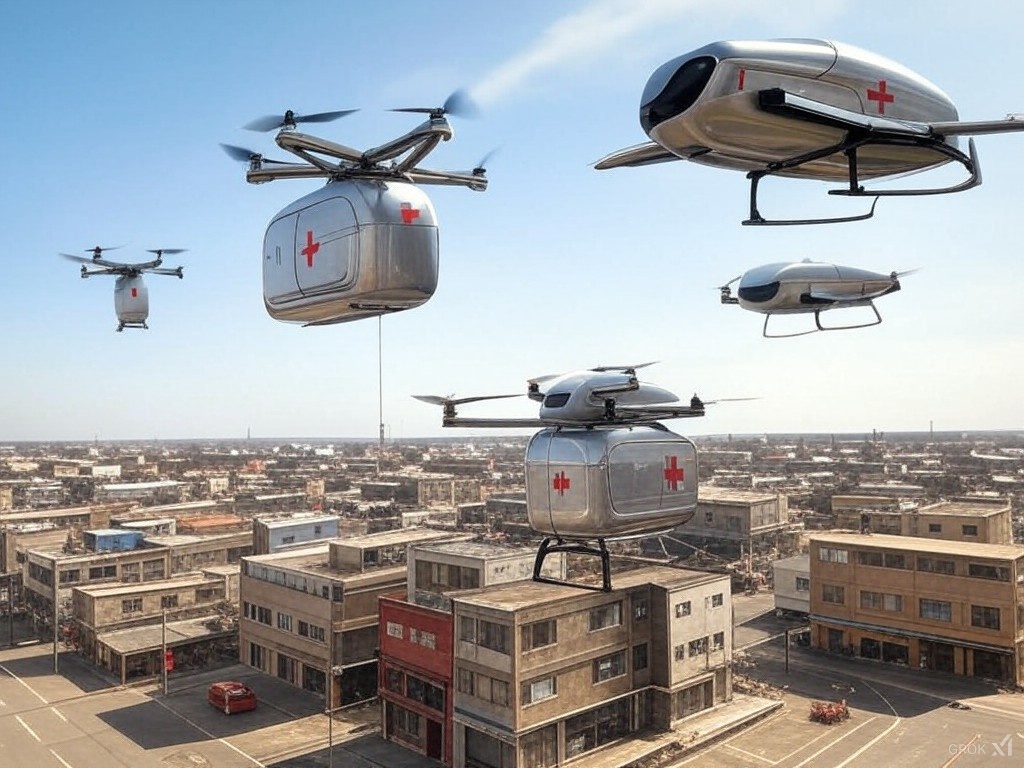The Stunning Economics of Drones in 2025
19th February 2025
Predictions about flying objects have always been fiendishly tricky to get right. For example, legendary aircraft pioneer Orville Wright was not especially optimistic about the future of flight (see below).
“No flying machine will ever fly from New York to Paris.”
Something similar happened to Western developers of drones (‘remotely piloted vehicles,’ or RPVs), which were first introduced in Britain and the United States over a century ago, during the First World War.
Even 10 years ago, no one could have predicted the eventual near-total dominance of one country in the manufacture of and technological lead in drones.
China now has a stranglehold on the commercial drones market and is leapfrogging the rest of the world in military drones (both aerial and underwater.)
According to the Center for Strategic and International Studies (CSIS), ‘China is the undisputed leader in commercial drone production. The DJI Technology Company, a Chinese company and the world’s largest commercial drone manufacturer, holds a remarkable 90 percent share of the U.S. commercial drone market and 80 percent of the global consumer drone market.’
For the Western world, which has transferred most manufacturing to China over the past three decades , the biggest peril lies in the fact that even the few drone manufacturers that still exist in the West have to rely on China for critical components and spare parts.
In an age when thought leaders envision a world in which everything from medical emergencies to farming and policing is set to be revolutionised by drones, this extreme imbalance in favour of China is deeply worrying to governments.
Especially troubled are military planners, who have watched with growing consternation the role of cheap drones in the Ukraine war. War machines worth trillions of dollars built up over decades in the West are looking increasingly fragile.

Figure 1: China has technologically far outpaced the United States in drones.
Critical medical care is a great illustration of the power of drones to potentially transform a key area of essential services.
Drones may do something truly dramatic: replace ambulances with a cluster of small drones that fly over frequent traffic snarls, carrying patients in suspended pods and saving countless lives.
In other situations, drones can rush life-saving supplies—like defibrillators, medicines, and even blood—to people in need much faster than traditional ambulances.
Most drones now have cameras and sensors that give first responders a live view of the situation before they arrive. This extra layer of situational awareness allows emergency crews to act more confidently and quickly.
While we’re still figuring out the best ways to incorporate drones into our emergency response systems, the technology and regulations are evolving hand in hand. With ongoing research and teamwork among tech experts, healthcare professionals, and policymakers, drones are set to play a key role in speeding up care and ultimately saving more lives during emergencies.

Drones will revolutionise emergency medical care.
Australia is just waking up – perhaps too late – to the need for more investment in drone technology, and better integration of drones into various sectors of the economy.
Just last year, Australia’s government-run Advanced Strategic Capabilities Accelerator (ASCA) program handed out multi-million dollar contracts to AMSL Aero, Boresight and Grabba Technologies in the next stage of the Sovereign Uncrewed Aerial Systems (UAS) Challenge. This program will attempt to build Australia’s sovereign drone manufacturing capability.
Besides the obvious military imperatives, with the ambitious AUKUS nuclear submarine program clouded by questions like “What if potential adversaries simply flood the oceans with cheap underwater drones, rendering stealth nuclear submarines useless,” Australia’s frequent trauma from natural disasters could do with some help from drones.
Small teams, such as that led by Associate Professor Roslyn Prinsley, head of the Australian National University’s (ANU) Disaster Solutions, are trying to make a difference.
“One of the main things we’re looking at are these scout drones, which are kind of a drone that has all these sensors on it that can see a lightning ignition as soon as it starts,” Prof. Prinsley told ABC News last month.
Sounds like a small, relatively inexpensive piece of technology. But such modest developments are set to proliferate, coalescing into a new era of how we run virtually every area of human activity.
The buzz of drones is intensifying, literally and metaphorically.
| Potential Economic Benefits of Drones Within a Decade | ||
| Key Area of Economic Activity | Aerial Drones | Underwater Drones |
| Agriculture & Aquaculture | – Precision Pollination & Seeding: Autonomous drones with AI-assisted pollination and seed deployment. | – Intelligent Stock Management: Real-time tracking of fish/shrimp health, feeding patterns, and biomass estimation in aquaculture pens. |
| – Real-Time Data Analytics: Advanced sensors and edge computing for crop disease and nutrient deficits. | – Underwater Cage Maintenance: Robotic arms repairing nets and structures, minimising human diver risk. | |
| – Automated Harvesting: Specialised drones that gently pick and transport high-value produce. | – Integrated Water Chemistry Sensors: Instant pH, nutrient, and contaminant analysis. | |
| Infrastructure & Construction | – 3D Printing & Assembly: Swarms of construction drones capable of delivering and depositing building materials (e.g., additive manufacturing in inaccessible or risky environments). | – Subsurface Infrastructure Inspection: High-resolution sonar and imaging for early detection of corrosion or cracks in foundations, piers, and tunnels. |
| – Autonomous Structural Health Monitoring: AI-driven drones that continuously scan bridges, skyscrapers, and tunnels for micro-cracks or stress points. | – Smart Robotics: Drones that can perform basic underwater construction tasks like welding, rivet application, and sealing. | |
| – Safer High-Rise Maintenance: Drones replacing human labour for tasks like painting, cleaning, and small repairs. | – Real-Time Digital Twin Updates: Drones feeding data to 3D models for predictive maintenance. | |
| Energy (Oil & Gas, Renewables) | – Automated Asset Patrols: Continuous inspection of solar farms, onshore wind turbines, and pipelines for leaks or performance issues. | – Subsea Pipeline & Cable Inspection: Enhanced AI-driven fault detection in deep-sea pipelines and undersea power cables. |
| – Dynamic Wind Turbine Cleaning & Repair: Drones with specialised attachments to clean blades and fix minor damages mid-operation. | – Offshore Renewables Support: Maintenance of floating wind turbines or marine turbines using multi-drone coordination. | |
| – Green Energy Integration: Coordinating power grid balancing by monitoring renewable assets’ output in real time. | – Deep-Sea Resource Surveys: Identifying potential sites for seabed minerals with minimal environmental disruption. | |
| Environmental Monitoring & Conservation | – Advanced Emissions & Air Quality Tracking: Networked drones that sample and analyse pollutants, greenhouse gases, and particulate matter. | – Coral Reef Restoration: Drones capable of planting coral fragments or deploying reef-friendly substrates. |
| – Ecosystem & Biodiversity Surveys: AI-based identification of species and real-time habitat mapping. | – Marine Pollution Cleanup: Swarms locating and removing plastics or other pollutants. | |
| – Carbon Capture Drones: Early-stage prototypes testing direct air capture of CO₂. | – Ecosystem Health Analytics: Hyper-spectral imaging to track fish populations and water chemistry for early signs of ecosystem distress. | |
| Disaster Management & Humanitarian Aid | – Predictive Disaster Detection: AI-enabled drones analysing weather patterns and geological data to provide early warnings for floods, storms, earthquakes, or landslides. | – Underwater Disaster Assessment: Drones mapping flood zones, checking structural integrity of dams or levees, and detecting submerged debris. |
| – Rapid Relief Delivery: Autonomous drone corridors to distribute medical supplies, food, and emergency kits in conflict or disaster zones. | – Subsurface Rescue Operations: Specialised rescue drones for locating survivors in submerged vehicles.. | |
| – Search & Rescue: Thermal imaging and AI-driven victim identification in collapsed structures or remote areas. | – Environmental Recovery Assistance: Helping remove toxic materials from waterways after industrial disasters. | |
| Security & Defence | – Persistent Perimeter Monitoring: AI-driven drones operating 24/7 with advanced facial and object recognition for border and critical site security. | – Coastal & Harbor Security: Autonomous underwater vehicles patrolling ports to detect unauthorised divers, subsurface drones, or illicit cargo. |
| – Intelligent Threat Detection: Swarm technology for real-time crowd surveillance and anomaly detection (e.g., hidden weapons, suspicious behaviour). | – Anti-Submersible Operations: Drones fitted with sonar arrays to identify and track submarine threats. | |
| – High-Risk Mission Replacement: Drones replacing human soldiers for reconnaissance, bomb disposal, and infiltration tasks. (Of course, drones also directly fight wars and do violence, as seen in Ukraine). | – Critical Infrastructure Defence: Early detection of sabotage or infiltration of underwater pipelines and cable systems. | |
| Transportation & Logistics | – Advanced Aerial Delivery: High-capacity drones transporting larger cargo volumes and performing last-mile deliveries, reducing road congestion. | – Maritime Shipping Efficiency: Underwater drones scanning shipping routes for hazards like sunken containers, and optimising routes for large vessels. |
| – Drone Taxis & Passenger Transport: Urban air mobility services offering short-distance commutes via eVTOL (electric vertical take-off and landing) drones. | – Hull Inspections & Maintenance: Automated drones cleaning and inspecting the hulls of cargo ships to reduce drag and improve fuel efficiency. | |
| – Traffic Flow Optimisation: Real-time data for autonomous vehicle routing, accident detection, and dynamic road pricing. | – Subsea Cargo Transport (Experimental): Early prototypes transporting specialised goods between coastal hubs via sealed drone cargo pods. | |
| Research & Exploration | – Planetary Analogs & Extreme Terrain: Drones with advanced sensors studying volcanic areas, polar regions, and other hazardous sites as analogs for space exploration. | – Deep-Ocean Research: Next-gen submersibles reaching extreme depths with better endurance, assisting in mapping uncharted seafloors. |
| – Citizen Science Contributions: Networks of low-cost drones collecting distributed data on wildlife, weather, and ecological changes. | – Marine Archaeology: High-resolution imaging for exploring shipwrecks and underwater ruins, reconstructing 3D models for cultural preservation. | |
| – High-Altitude Research: Solar-powered stratospheric drones for continuous atmospheric observation. | – Under-Ice Exploration: Drones capable of drilling through ice sheets in polar regions to examine subglacial lakes and ecosystems. | |
| Tourism, Media & Entertainment | – Immersive Aerial Experiences: VR/AR-enabled flight tours over natural wonders, historical sites, and mega-events. | – Underwater Tourism: Real-time feeds from drones exploring coral reefs, shipwrecks, and marine life for virtual or on-site guided tours. |
| – Live-Streamed Content: Next-gen 360° cameras for real-time broadcasts of concerts, sports, or festivals, offering a “drone’s eye view.” | – Entertainment Robotics: Interactive underwater shows featuring choreographed “schools” of robotic fish or marine drones. | |
| – Interactive Drone Shows: Precisely choreographed drone fleets creating aerial art and advertisements in large-scale events. | – Eco-friendly Excursions: Minimising human disturbance while still enabling close-up observation of fragile underwater ecosystems. | |
| Public Health & Safety | – Medical Delivery & Triage: Automated drones distributing vaccines, medications, or portable diagnostic devices, especially in remote or quarantined areas. | – Clean Water Assurance: Underwater drones continuously sampling municipal water supplies, reservoirs, and desalination plants for contaminants. |
| – Disease Vector Control: Targeted spraying of mosquito breeding sites or infection hotspots with eco-friendly treatments. | – Beach & Coastal Safety: Drones monitoring rip tides, jellyfish swarms, or pollution levels and alerting local authorities. | |
| – Pandemic Monitoring: Drones gathering real-time data on crowd density, compliance with health guidelines, and environmental indicators. | – Wastewater Monitoring: Early detection of viral or bacterial outbreaks in sewage systems for quick public health response. | |
At MyTreasur-e, we keenly track technical, social, economic, and financial trends that can impact our customers. Our passion for anticipating and managing risk in all its forms is what accounts for our customers’ satisfaction with our cutting-edge treasury and risk management solution.

